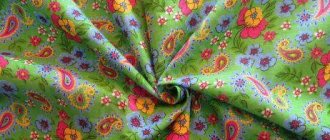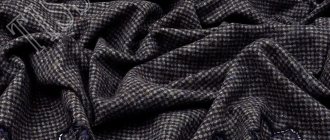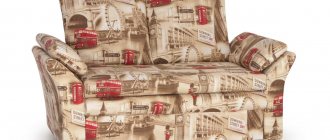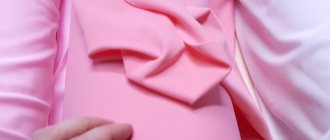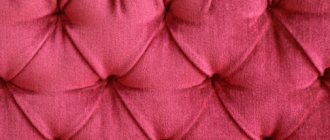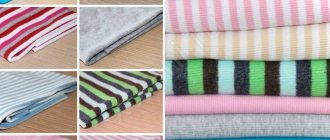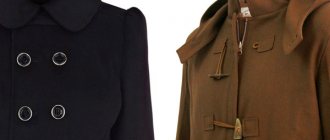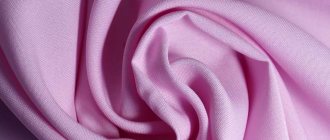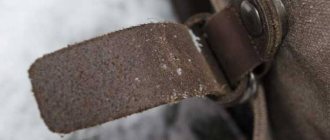Cute multi-colored women's drape coats, tailored according to the latest fashion trends, are worn with pleasure by both young girls and older ladies. Warm, comfortable, pleasant to the touch, suitable for winter frosts, autumn bad weather and spring warmth. Drape proved itself brilliantly many years ago and still retains its leading position among coat fabrics.
What kind of fabric is drape, its composition and quality
A word familiar from childhood is drape, which is associated with a large, warm winter coat. Indeed, drape is a very warm fabric, woven with a complex weave of real wool thread. This material has many varieties - with and without pile, with a clear thread pattern and smooth, plain and multi-colored. The fabric is reversible, has a distinct back and front side, and the front side is usually made of finer, high-quality wool. Modern drape contains half-woolen and synthetic threads, which makes the fabric more durable, but the wool component is significant.
To make a drape product warm and wearable, you should pay attention to the ratio of wool and impurities. The best formula, tested by time and weather - 80% wool and 20% synthetic additives.
What kind of fabric
Drape is a fabric known as a type of cloth. What is cloth? This is a material in which the fibers are so tightly packed that they leave no gaps. The characteristics of drape material vary depending on the type of fabric. If it is a completely woolen material, then it will be more expensive, however, pure woolen fabrics are made less and less often, which is associated not only with the price of raw materials, but also with the low wear resistance of the material.
Cashmere and drape are noble materials that are used in the production of elite clothing, but mixed varieties are available to a wide range of consumers. The difference between these materials is density and weight. Cashmere is lighter and softer, but it is also more expensive. Drape is a universal material, which is characterized by accessibility and durability.
According to the description, drape fabric is a two-layer material, with higher quality raw materials often used on the front side. What kind of fabric is this, if we talk about its production technology? This is a hardware weave fabric, often with a brushed surface.
This season's drape coats: trends, styles, models; traditional and fashionable colors
Drape fabric fits perfectly on any cut, so the variety of models and styles is huge. This is mainly a coat, but you can sew jackets, suits, skirts, jackets and trousers - literally all products look beautiful and stylish. This season's warm clothing collections include models made entirely from drape and those combined with leather, suede, and fur.
Main models of the season
Classic trapezoidal and straight silhouettes are always fashionable and relevant, suitable for almost any figure. Tall, not overweight ladies can wear a fitted drape coat, which will emphasize their slimness.
Double-breasted styles are again relevant, not only in the usual design, but with the use of large bright buttons, the same belt, and the lower part of the collar. The colorful additions fit into the eclectic mix and match style that appeals primarily to young people. Here it is appropriate to remember the oversized style, when clothes are specially selected one size larger, creating additional volume. This technique allows you to mask some figure flaws, and skillfully selected clothes completely change your usual image.
In the spirit of the times, the “military” style is made of deliberately rough material, with all the shoulder straps, pockets, and tabs befitting a militant style. No less relevant are asymmetrical models, cut at the waist and one-piece, with uneven floors and a deep smell. Interesting models with a zipper, open or closed flap. A large metal zipper can become an additional decor for a demi-season model.
Color palette
Traditionally, drape fabric is monochromatic, with a pattern created by the interweaving of threads. The trends of modern fashion, with its richness of colors, shades, and color solutions, are perfectly embodied in drapery fabric. Plain mustard, gray, and brown colors remain in trend, but young people prefer richer colors.
Designers are developing models with purple, green, turquoise shades and pure colors that are unusual for warm products. The photo gallery presents several options for bright coats, executed in a modern style, taking into account the wishes of all segments of women's society.
Separately in high fashion collections and for everyday wear there is a cage. Photos of checkered new items and traditional models will help you choose the most interesting model that matches the color and character. It can be a polychrome Scottish or two-color Provence check, a small black and white check, or even a combination of the two types. The check is always fashionable, but now it is in favor.
Length
The length today does not reach the floor; coats usually end just below the knee. Depending on habits, age, courage, ladies allow themselves to complement a warm drape coat with equally warm trousers, tight-fitting leggings, and a straight skirt. Of course, every fashionista has the right to choose a comfortable style - long, medium or short.
Characteristics of drape and types
The drape fabric is two-layer and has high heat-insulating properties. In addition, the material does not wrinkle, holds its shape well, giving the figure a clear, beautiful silhouette.
Drape fabric necessarily contains natural wool fibers, but synthetic threads can also be added to increase the wear resistance of the product. If the fabric contains up to 15% of additives, the material is considered wool, if more (from 15 to 70%) - half-woolen. The top layer of this material is made of wool, and the lining is made of synthetics. Thus, the fibrous composition of the drape is divided into wool and half-woolen fabric.
You can read about what gabardine is in another place.
All wool materials are here.
Depending on the structure of the pattern and weave, drapery material can be:
- brushed;
- lint-free;
- plain;
- multicolor.
The fabric is produced by one-and-a-half or double weave of threads and is subject to machine pressing and then napping. With this treatment, a fluffy, velor or smooth surface is obtained, and the weaving of the fibers becomes almost invisible.
Look at the description of materials for outerwear in the article “Materials for Coats”. And finally, you can read about jersey knitwear - what kind of fabric it is and what its composition is.
Winter and demi-season models
Drape fabric is very warm, especially designed for winter cold. A winter coat can be additionally insulated with a natural or synthetic quilted lining, a large fur collar, a deep hood, and cuffs. It is warm and beautiful to cover your shoulders with a boa made of natural or artificial bio-fur. A winter coat made of drape is good form, almost a necessity for ladies. It not only helps out in any situation, but is also beautiful in itself.
Demi-season, autumn models are convenient because they are quite warm, but at the same time light, and can be tailored according to the latest fashion or remain traditional. Demi-season drape coats with a light lining are universal. By the way, there are models that are equipped with an insulating lining with a zipper, which is extremely convenient in the first days of winter, when the frost is not yet raging.
Types of fabric and its use
Over the years, textile workers have invented many varieties of this wonderful cloth; they are divided into men's and women's.
- Men's linens are distinguished by a restrained color scheme and high density. These are heavier fabrics. A men's drape coat can be made of one-and-a-half-layer or two-layer cloth.
- Women's fabrics are lighter and brighter. Modern women's drape coats are made from materials of various colors and textures. Children's coats are made from lighter one-and-a-half-layer fabrics. In the catalogs of online stores, fashion houses and clothing companies you can find photos of coats of various styles.
According to the method of dyeing, drapery fabrics are classified as follows:
- one-color drape - a plain-dyed fabric made of threads of the same color;
- multicolor - when weaving, threads of different colors are used. Melange drape using threads of two colors is popular, including patterned melange drape. Chanel's style, based on sewing women's business suits from single-layer thinned houndstooth cloth, gained worldwide fame.
In addition, coat drape fabrics are distinguished by the presence and method of processing the pile during the pressing process. The pressed material comes in the following types:
- unlinted - smooth matter;
- fluffy - a two-layer fabric with goat down added to the front layer;
- velor drape - has a short pile, perpendicular to the surface;
- drape ratin - fibers are laid diagonally across the fabric in narrow strips;
- drape in the bottle - the pile is laid out in patterns.
Warm outer clothing is sewn from drape materials and used in furniture production; mixed and synthetic versions are used for workwear. Thin single-layer fabric is used for suits, drape coats for girls, skirts and dresses. One-and-a-half-layer types are used for autumn coats, and two-layer fleeced ones are used for winter coats.
The advantages of cloth are undeniable:
- high degree of thermal insulation;
- breathability and at the same time protection from wind;
- density, strength and durability;
- ability to maintain shape.
What to wear with a fashionable drape coat
Any clothing, especially warm outerwear, requires additions.
Headdress. There are not, and cannot be, any strict rules here; the main condition is that the hat, beret, and scarf must please, protect from the wind and keep you warm in the cold. Demi-season headwear can be flirty and unusual: traditional knitted hats, felt and velor berets, playful scarves, a snood scarf draped over the head.
You should choose gloves and a scarf to match the headdress. The winter version of gloves and mittens has the main purpose of warming your hands, while the demi-season version has a more decorative focus: you can decorate the gloves with embroidery, rhinestones, and appliqué. Leather gloves of all types and colors are very good. Scarves this season defy description: knitted and woven, wide and narrow, striped and plain, casually thrown over the shoulders or tied around the neck - all are good, beautiful, fashionable, the only requirement is to try to maintain the harmony of the image.
Since this season's coats are not long, the issue of suitable shoes is acute. Winter dictates its own rules: boots of all modifications, with thick soles, with natural and faux fur, with or without zippers, with cuffs, knee-high or short boots, elegant model options and affordable ugg boots. The demi-season version amazes with its variety. Shoes, ankle boots, sneakers, pumps. Heel and flat sole. Zippers, snaps, buttons and beautiful lacing.
It is highly undesirable to wear summer shoes under a coat, no matter how avant-garde it may seem. The same goes for large warm scarves - shawls, which look out of place on warm spring days. Harmony is desirable in everything, even among adherents of kitsch and avant-garde.
Caring for drape clothing
A win-win option for cleaning a winter or demi-season drape coat is dry cleaning. Our specialists know how to handle natural and mixed fabrics and you don’t have to worry about noticeable stains remaining.
If this is not possible or is undesirable for some reason, it is not difficult to clean the drape product at home. First of all, you should inspect all coats and determine the degree and quality of contamination.
The drape is easy to clean with a brush, dry or slightly damp. In case of heavy soiling, you can sprinkle the dampened area with the stain with washing powder for woolen fabrics. After the powder has dried, use the same brush to gently brush it off and then shake well.
During the summer, you should store your drape coat like regular winter clothes - straightened out on hangers, in a plastic case, with a bag of anti-mol medication hanging on the hangers.
Product care
Coat items are not washed, but are dry cleaned at least once a season. Daily care consists of cleaning with a clothes brush. Things can be steamed. Trousers and skirts can be washed gently by hand as follows:
- use special products for cloth;
- do not rub the products;
- do not twist;
- Allow clothes to drain after rinsing and dry on hangers.
Drape cloth is a universal material that is timeless and fashionable. Clothes made from it will always be relevant. A well-chosen model and good cut will always make you look elegant and stylish.
Also read on our website about another popular coat fabric - boucle.


